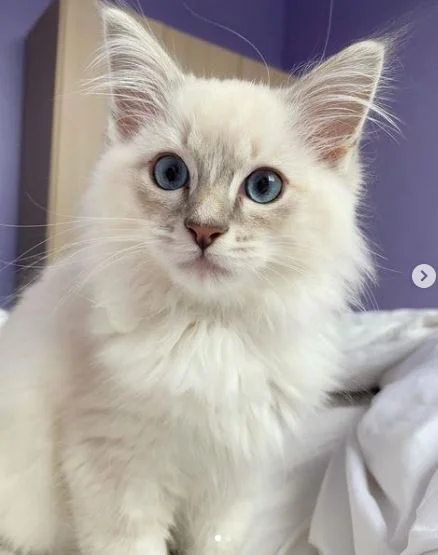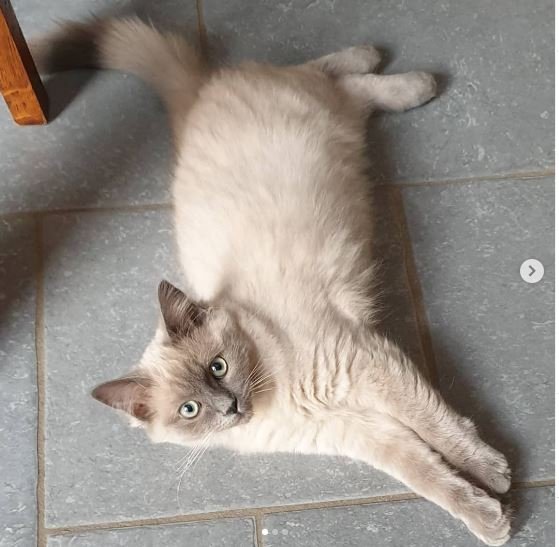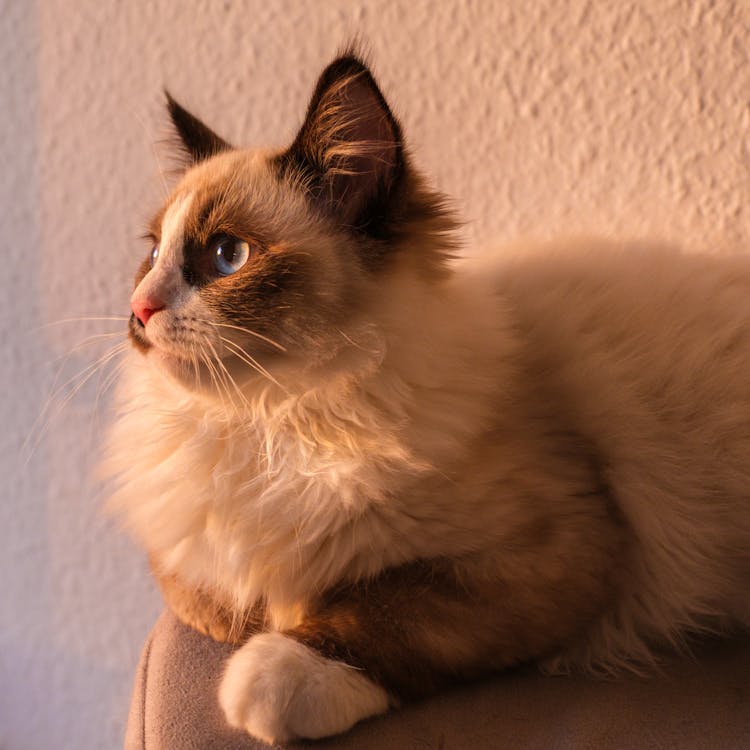The Ragdoll cat, renowned for its striking blue eyes and luxurious, semi-long fur, is one of the most beloved cat breeds globally. Known for their affectionate and laid-back nature, Ragdolls make fantastic pets. One common question prospective Ragdoll cat owners might ask is,
“How many kittens do Ragdolls have?”
Ragdoll cats typically have 4 to 6 kittens in their litter, but variations occur due to genetics, [power, and the mother cat’s health. Providing a warm environment and a balanced diet and monitoring kitten milestones are vital for their development. Keep an eye out for any health concerns early on. Socializing them helps build confidence and fosters good behavior. Ensuring their nutritional needs are met is essential for their growth.
Finding forever homes involves thorough screening and long-term commitment. Enjoy the journey with Ragdoll kittens by creating a safe environment and nurturing them through each stage.
Average Litter Size of Ragdoll Kittens
Exploring the average litter size of Ragdoll kittens reveals a significant range of 4 to 6 kittens in one litter. Ragdolls generally give birth to around 5 kittens, although variations occur.
The birthing process usually occurs in a single session, although labour may extend over multiple days in rare instances. Responsible breeders diligently oversee each kitten’s health and development within the litter to guarantee their overall well-being.
It’s fascinating to witness the variation in litter size among Ragdolls. Factors like genetics, the mother cat’s age, and her health play vital roles in determining the number of kittens born in a single litter. Observing these dynamics adds depth to our understanding of Ragdoll breeding practices and outcomes.
Factors Influencing Litter Size Variation
Genetics play a vital role in determining the size of a Ragdoll litter.
Additionally, the nutrition provided to the queen during pregnancy can impact the number of kittens she delivers.
Moreover, the overall health of the mother cat is a key factor that influences the size of the litter she can successfully carry to term.

Genetics Impact Litter Size
Analyzing the impact of genetics on litter size variation in Ragdoll cats reveals key factors influencing the number of kittens in a single litter. Genetics play an essential role in determining the potential litter size range for Ragdolls, with certain genes influencing the number of kittens a cat may have.
Factors such as the genetic history of the parent’s inherited traits related to fertility and genetic predispositions towards larger or smaller litter can all contribute to the variability seen in Ragdoll litter sizes. By understanding the genetic makeup of breeding cats, breeders can make informed decisions to promote healthy litter sizes within the typical range for Ragdolls, which generally fall between 4 to 6 kittens per litter.
Nutrition Affects Kitten Numbers
Proper nutrition during pregnancy greatly influences the number of kittens a Ragdoll queen may have in a litter. Nutrition plays a significant role in determining litter size, with malnutrition potentially resulting in smaller litter.
Queens that receive a balanced diet and sufficient food intake are more likely to give birth to larger litters of healthy kittens. Hence, focusing on ideal nutrition and care in breeding practices can help maximize litter sizes and promote the well-being of both the queen and her offspring.
Health Influences Litter Size
Factors such as the queen’s age, health, genetics, and breeding practices play a significant role in influencing the variation in litter size among Ragdolls.
The queen’s immune system health ensures successful pregnancies and larger litter sizes. A strong immune system can help prevent infections and diseases that may impact the queen’s ability to carry a full litter to term.
Genetics also determine the queen’s overall health and reproductive capabilities, which can affect litter size.
Responsible breeding practices that prioritize the health and well-being of the queen can contribute to maintaining ideal litter sizes in Ragdolls. By considering these factors, breeders can help promote the health and vitality of both the queen and her kittens.

Care Tips for Ragdoll Kitten Litters
How can we guarantee the well-being of both the mother cat and her Ragdoll kitten litters during the postpartum period?
When caring for a Ragdoll’s first litter, ensuring a warm and quiet environment is essential. The mother should have a secluded nesting area with minimal disturbance to reduce stress.
Provide a high-quality, balanced diet to support her increased nutritional needs during nursing. Regularly check the kittens for proper nursing and weight gain to monitor their health.
Keep the living space clean and warm to prevent infections. Additionally, consult a vet for guidance on any unexpected issues and to schedule necessary vaccinations.
Monitoring Kitten Development Milestones
To guarantee the healthy growth and development of Ragdoll kittens, it’s important to monitor specific milestones, such as weight gain, eye and ear development, and motor skills.
- Weight Gain: Regularly weigh the kittens to confirm they’re steadily gaining weight, indicating proper growth.
- Eye and Ear Development: Monitor the kittens’ eyes and ears, as they should be opening and developing normally.
- Motor Skills: Encourage kittens to start exploring and playing to help them develop essential motor skills.
Identifying Health Concerns in Kittens
We must be vigilant in monitoring Ragdoll kittens for any signs of health concerns, such as distress, physical abnormalities, or weight fluctuations. Keeping a close eye on their well-being is vital to guarantee they grow up healthy and happy. Regular check-ups and observations can help detect any potential issues early. One important aspect of monitoring is tracking their weight gain, as sudden fluctuations could indicate underlying health problems. Below is a simple table to illustrate key health concerns and monitoring strategies for Ragdoll kittens:
| Health Concerns | Monitoring Strategies |
|---|---|
| Distress symptoms | Watch for lethargy, appetite changes, abnormal breathing |
| Physical abnormalities | Regularly check for any irregularities in appearance or behavior |
| Weight fluctuations | Keep track of weight gain to assess overall health and development |
Socialization Strategies for Ragdoll Kittens
Let’s talk about how to socialize Ragdoll kittens effectively.
Playtime is essential for building their confidence and sociability, while regular handling and cuddling help them feel secure and loved.
Introducing them to new environments gently will help them grow into well-adjusted and friendly cats.
Playtime for Socialization
Engaging Ragdoll kittens in playtime is essential for promoting socialization and fostering positive interactions. Playtime not only provides physical exercise but also helps kittens develop essential social skills.
Here are some strategies to make playtime beneficial for your Ragdoll kitten:
- Use interactive toys, feather wands, and catnip toys to stimulate play and mental engagement.
- Supervise play sessions to guarantee safety and monitor kitten behavior closely.
- Incorporate playtime into daily routines to encourage healthy development and social skills.
Handling and Cuddling
Handling and cuddling play an important role in promoting socialization and building trust during playtime interactions with Ragdoll kittens. One should handle Ragdoll kittens gently and frequently to help them feel comfortable with human touch.
Regular cuddling sessions not only assist in establishing trust but also create positive associations with human interaction. It’s vital to gradually introduce new experiences and environments during cuddling to familiarize kittens with various stimuli, aiding in their adaptation to different situations.
Incorporating interactive play into cuddling sessions can also enhance physical activity and mental development in kittens. By maintaining consistent handling and cuddling routines, one can contribute to the development of well-adjusted and affectionate adult Ragdoll cats.
Exposure to New Environments
Gradually introducing Ragdoll kittens to new environments is essential for their socialization and overall development. When it comes to socializing Ragdoll kittens, we focus on controlled exposure to various stimuli to help them grow into well-adjusted adult cats.
Here are three key strategies for successful socialization:
- Supervised introductions: Allowing Ragdoll kittens to interact with other pets under supervision helps them learn appropriate social behaviors.
- Interactive play sessions: Engaging Ragdoll kittens in play helps build their confidence and strengthens the bond between the kitten and their human companions.
- Desensitization to noises: Exposing Ragdoll kittens to common household sounds from an early age helps prevent fear and anxiety in unfamiliar environments.
Nutritional Needs of Ragdoll Kittens
When raising Ragdoll kittens, it’s important to provide them with specialized kitten food to support their rapid growth and development. From the moment they’re weaned until they reach around twelve months old, Ragdoll kittens require high-quality kitten food to adequately meet their nutritional needs.
Monitoring their food intake is essential during growth spurts to prevent malnutrition and ensure proper development. Establishing regular feeding schedules and practising portion control is necessary for maintaining their health.
Proper nutrition is essential for guaranteeing the overall well-being and proper growth of Ragdoll kittens. By prioritizing their nutritional needs, we can help them thrive and become healthy adult cats.
Finding Forever Homes for Ragdoll Kittens
Securing suitable forever homes for Ragdoll kittens involves thoroughly screening potential adopters to guarantee a good match. When looking to find someone to adopt a Ragdoll kitten, it’s essential to take into account the following:
- Home Environment: Ensuring the adopter can provide a safe and loving space for the kitten.
- Commitment: Finding someone dedicated to the long-term care and well-being of the Ragdoll kitten.
- Adoption Agreements: Requiring potential adopters to sign contracts outlining care responsibilities and spaying/neutering agreements.
Enjoying the Journey With Ragdoll Kittens
Let’s begin the delightful journey of raising and cherishing Ragdoll kittens.
First, it’s important to establish a warm and safe environment for the newborn kittens as they progress from their solid white coat to developing their unique color and markings.
Monitoring the mother cat during labour is vital to guarantee all kittens are delivered safely.
As the kittens grow, providing proper care and attention is key to their healthy growth and development.
Enjoying the journey with Ragdoll kittens involves nurturing them through each stage, from their curious explorations to their playful antics.
Witnessing their personalities unfold and forming bonds with these adorable creatures is a rewarding experience that deepens our love for these special feline companions.
Frequently Asked Questions
How Long Is a Ragdoll Cat Pregnant For?
Pregnancy duration in Ragdoll cats typically lasts around 63 to 65 days. We’ve observed that the average gestation period for these cats ranges from 9 to 10 weeks. It’s fascinating to learn about their reproductive cycle.
How Long Is a Ragdoll a Kitten For?
Growing like weeds, Ragdoll kittens remain in their kitten stage until they are one year old. Their playful antics, energetic bursts, and curiosity define typical kitten behavior. Proper care is essential.
Are Ragdolls Happier in Pairs?
Playful companions can greatly enhance Ragdolls’ happiness and well-being. Having a pair of Ragdolls promotes social interactions, prevents loneliness, and enriches their lives. We’ve found that two Ragdolls tend to thrive together, enjoying mutual stimulation and companionship.
How Big Is a 12-Week-Old Ragdoll Kitten?
At 12 weeks old, Ragdoll kittens reach growth milestones. They typically weigh 4-6 pounds, showcasing their breed traits like big ears and blue eyes. With proper care, these playful and friendly kittens grow rapidly.
Conclusion
To sum up, raising Ragdoll kittens can be a rewarding experience. From monitoring their development milestones to finding forever homes, it’s important to provide love, care, and attention every step of the way.
By understanding their nutritional needs and socialization strategies, we can guarantee they grow up to be happy and healthy cats.
So let’s continue enjoying the journey with our adorable Ragdoll kittens!

Hey guys, My name is Simon Smith. I’m from Canada and live near Victoria
I live with my sweet family and have 20+ Ragdolls of different types. I love them as my children. My profession is as a hotel manager.
I love to keep Ragdolls and grow their breeder case. I have 7 years of experience.
I’m an expert in cat care. So, I’m here to provide you with new information about my cats daily. This is my blog website, so I request that you kindly visit our site daily.
If you’re a Ragdolls lover and you have any questions or confusion about cats, text me on the Contact Us page or Gmail.
Thank u
